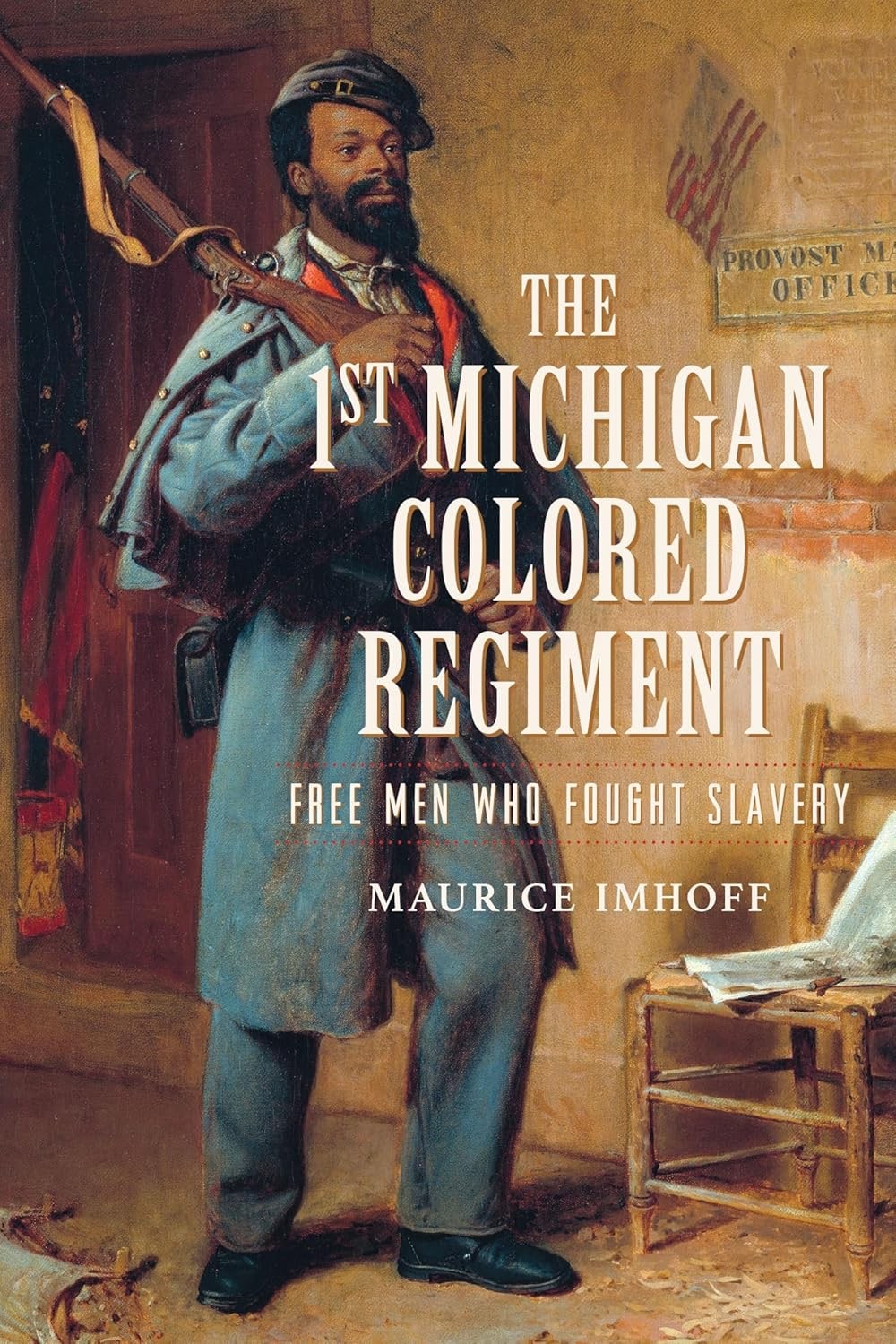Book Review:The 1st Michigan Colored Regiment: Free Men Who Fought Slavery

 The 1st Michigan Colored Regiment: Free Men Who Fought Slavery. By Maurice Imhoff. Charleston, SC: The History Press, 2025. Softcover, 192 pp., $24.99.
The 1st Michigan Colored Regiment: Free Men Who Fought Slavery. By Maurice Imhoff. Charleston, SC: The History Press, 2025. Softcover, 192 pp., $24.99.
Reviewed by Tim Talbott
While scholarship on the service of the United States Colored Troops (USCT) has primarily focused on the better-known regiments and battles, and the various traditional topical subjects, readers are starting to have opportunities to learn about previously underexamined actions and units.
Adding to what appears to be a sudden surge in publications discussing the 1st Michigan Colored Infantry (later redesignated as the 102nd United States Colored Infantry) is Maurice Imhoff’s The 1st Michigan Colored Regiment: Free Men Who Fought Slavery. Imhoff’s study joins recent books like Private No More: The Civil War Letters of John Lovejoy Murray, 102nd United States Colored Infantry, edited by Sharon A. Roger Hepburn (UGA Press, 2023), and Warriors for Liberty: William Dollarson & Michigan’s Civil War African Americans, edited by Jack Dempsey (Mission Point Press, 2024).
When one thinks about USCT regiments recruited in the Free States, the 54th and 55th Massachusetts, or the 5th USCI (Ohio) and 6th USCI (Pennsylvania), and 1st Kansas Colored Infantry often first come to mind. However, there were several units from the Midwest that donned the Union blue, shouldered a rifle, and marched forth to end slavery and place a worthy claim to citizenship and equality. Units like the 29th USCI (Illinois), the 28th USCI (Indiana), and 27th USCI (Ohio), and of course, Michigan’s 102nd USCI, all also provided excellent service to the US Army.
In The 1st Michigan Colored Regiment, Imhoff provides an excellent portrait of Michigan’s only USCT unit and its legacy across 23 mainly brief chapters. He first offers readers valuable context on Michigan’s political character and the state’s Black communities during the antebellum era. The state’s location near the Canadian border made it an attractive stopping point for some self-emancipated people who wished to remain within the United States. Other African American residents came from free backgrounds who had moved there from places like western New York and northern Pennsylvania and Ohio seeking work opportunities.
A number of Michigan’s Black men who were unwilling to wait for the state to formally begin enlisting them gave service to the state’s white regiments early in the war as officers’ servants, cooks, and teamsters. After the Emancipation Proclamation, others headed to locations like Massachusetts that began enlisting African Americans as soon as possible.
The 1st Michigan Colored Infantry was born during a time of racial trouble within the state. A race riot occurred in March 1863 that roiled Detroit, when a Black man was falsely accused of molesting a white girl and Black girl. The riot resulted in two Black deaths and numerous homes in their community being burned.
The spur behind the regiment’s formation was Henry Barnes, editor of the Detroit Advertiser & Tribune. During the spring of 1863, Barnes requested permission from Michigan’s Republican governor Austin Blair to recruit a Black regiment. Without authorization from the War Department yet, Blair denied Barnes. Undaunted, Barnes then applied directly to the War Department. Granted permission, enlistments began. Imhoff does a particularly good job of highlighting the partisan politics that played out especially in the opposing newspapers over that state’s attempt to form the 1st Michigan Colored regiment and during its time recruiting and training it.
Using the influence of national and local Black personalities the regiment organized and trained through the summer, fall, and winter of 1863-64, at Camp Ward, near Detroit. On January 5, 1864, the regiment received its flag from the Colored Ladies Soldiers Aid Society of Detroit. Additional delays in fully recruiting the regiment held up its deployment until finally mustering into service in March 1864.
Traveling by train to Annapolis, Maryland, the regiment was initially assigned to the Ninth Corps. However, they soon received orders to transfer to Hilton Head, South Carolina, where they served as garrison troops and were redesignated as the 102nd USCI. Brigaded with Black troops recruited from the slave states created some tension between the local units and the Michigan men, which Imhoff points out.
In early August 1864, the 102nd moved by ship to Florida for a raid which also brought its first real combat experience. To get the common soldier perspective, Imhoff uses the Pvt. John Lovejoy Murray letters mentioned above. The raid freed numerous enslaved people and captured horses and mules that were often in short supply for the Department of the South forces.
Returning to South Carolina, the 102nd continued garrison duty into the fall. On November 30, they participated in the Battle of Honey Hill where the regiment displayed conspicuous courage. They fought several other skirmishes during December and eventually moved to Savannah, Georgia, in the spring of 1865, before returning to South Carolina and seeing more action in operations that lasted into April. The 102nd served in an occupation duty role until the fall of 1865, when they returned to Michigan in October.
Imhoff continues the story into the 21st century by showing how efforts to remember the 102nd have created educational opportunities about Michigan’s Black Civil War soldiers. Through living history groups, highway historical markers, naming interstates, and now this book, the regiment and its solders continue to live on.
The 1st Michigan Colored Regiment makes an excellent addition to USCT and Civil War scholarship. A notes section shows Imhoff’s use of both primary and secondary sources to tell this story. Modern and historic photographs help readers visualize the places and people mentioned within the book. And while an index would have been a helpful addition, the book’s strengths far outweigh this omission. This fine book will hopefully serve as a motivation for others to explore additional USCT regiments still needing their histories told.